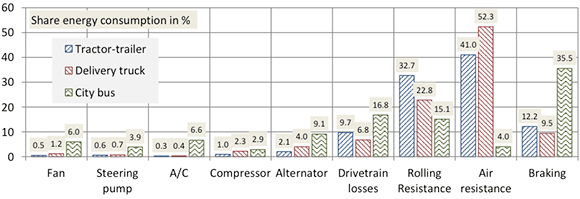Implementing fuel-saving technologies in VECTO: Options and estimated gains
Blog
Sneak peek into the EU's CO2 certification tool for trucks
As you read this, some programmers are toiling away in quiet obscurity for the European Commission, writing code that over the next decade and more will make a huge difference in how, and how much, European truck manufacturers invest in advanced fuel-saving technologies—a difference that will be measured not only in millions of Euros but in millions of barrels of oil. To understand how this works, you want to know a little about vehicle simulation software.
Vehicle simulation tools allow manufacturers, researchers, and regulators to virtually “build” and test vehicles. One purpose for which they’re used is to estimate vehicle fuel consumption over a variety of duty cycles. These estimations can be used to identify fuel-saving opportunities from a wide range of engine, transmission, and vehicle technologies.
Using simulation software has some advantages over empirical testing. Unlike engine dynamometer tests, simulations can capture the influence of the whole vehicle upon efficiency (including transmission gear ratios and efficiencies, aerodynamic drag coefficient, tire rolling resistance, payload, etc.). And, unlike whole-vehicle dynamometer testing, simulation makes it possible to test a high number of relevant vehicle variants with small marginal costs (isn’t it nice when you can have a computer do all the work?).
But there is a major downside to simulation tools: they require a lot of modeling work in order to capture the complexity of the interactions among the components of modern vehicles and their impact upon fuel efficiency. And not all vehicle simulation tools are created equal. Vehicle manufacturers use proprietary, sophisticated simulation tools for powertrain development, while the simulation tools used in regulatory environments are usually much simpler. Some of these regulatory tools are becoming more complex, but the final equilibrium point between simplicity and comprehensiveness is still uncertain: regulators favor transparency, and truck manufacturers require more sophisticated models to be able to demonstrate the benefits of advanced control systems and powertrain configurations (e.g., hybrid vehicles). At the same time, truck manufacturers are also wary of fully disclosing the details of these advanced technologies (even to regulators) because they want to protect their commercial interests.
Which brings us to those programmers toiling for DG-CLIMA. VECTO (Vehicle Energy consumption Calculation TOol) is the currently-under-development simulation tool for the monitoring of fuel consumption and CO2 emissions from HDVs in the European Union. Among the decisions that will be made in finalizing VECTO will be whether and how to implement several advanced fuel-saving technologies—such as hybridization, state-of-the-art auxiliaries, waste heat recuperation, or driver support systems—in the simulation tool. And whether the simulation tool is able to capture the benefits of a given technology can have a big influence on how motivated truck manufacturers will be in further investing in its development. Tools like VECTO or EPA’s Greenhouse Gas Emissions Model (GEM) are the ones that quantify, forecast, and promote truck efficiency technology, and they are the foundation from which all technologies will be measured for fuel efficiency gains (and CO2 reductions).
The ICCT has closely followed the evolution of vehicle simulation tools and their increasingly important role in regulatory contexts, starting with the US EPA’s simulation modeling in its light-duty greenhouse gas rulemaking, and we build and use simulation models ourselves—for example, in our ongoing work on the US Phase 2 heavy-duty regulation.
It’s out of that engagement that we commissioned the Technical University of Graz (TUG) to research technical options to implement advanced fuel-saving technologies in VECTO. TUG’s just-completed technical report gives an overview of VECTO’s current state of development, and provides different options to integrate new technologies including waste heat recuperation, intelligent management of auxiliary systems, advanced transmissions and hybrid powertrains.

Share of auxiliary consumers, drivetrain losses, driving resistances, and braking at the energy demand of typical HDV.
Mind you, this is a rather technical document, but it is also packed with insights into how heavy-duty vehicles use energy and other interesting tidbits for us truck geeks. If heavy-duty vehicle efficiency simulation is your thing, do take a look and let us know what you think!
